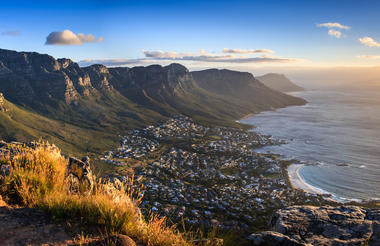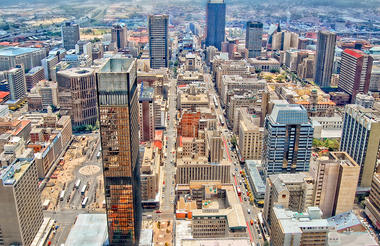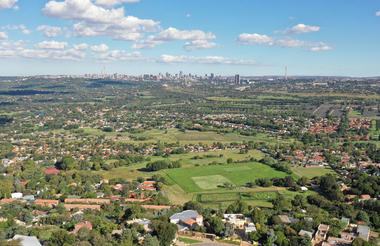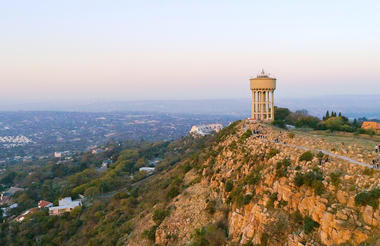Over the centuries, French, Dutch, English, Malay and African influences have moulded a city replete with natural beauty, an eclectic culinary smorgasbord, and a rich history. This is Cape Town, the Mother City, the oldest city in South Africa. And it’s where modern South Africa began. The seat of the South African parliament is here making Cape town the legislative capital of South Africa.
Cape Town has been called Table Bay, the Cape of Storms, the Cape of Good Hope, The Cape, and directors of the English East India Company described it as ‘the Gibraltar of India’. It finally became known as Cape Town in 1773. The Dutch East India Company had sent Jan van Riebeeck to build a fort, as well as The Company Garden - a vegetable garden and fruit orchard to supply ships on their way to the East and Australia with fresh food. A remnant of the garden still exists in the city today, including one of the original Saffron pear trees which is still bearing fruit. It’s the oldest cultivated fruit tree in the country.
The most prominent and iconic feature of Cape Town is Table Mountain. One of the New Seven Wonders of the world, and part of the Cape Floral Kingdom World Heritage Site, Table Mountain is one of the most popular visitor destinations in Cape Town. From the top, you can see the whole of the city laid out before you, as well the Pacific Ocean lapping at the foot of the African continent, and further along the coast is the Atlantic Ocean.
The mix of ethnic influences have, over the years, created a city with a unique, creative and cosmopolitan flavour unlike any other city in South Africa. All of which can be experienced in the museums, art galleries, spectacular seafood, the Victoria and Albert Waterfront, the Two Oceans Aquarium, the historic and important Robben Island. Wildlife such as great white sharks, penguins, seals, and iconic African wildlife in the nearby national parks. Cape Town also has one of the most colourful and photographed suburbs in all of South Africa – the Bo-Kaap. The narrow cobble streets and brightly painted homes on the slopes of Signal Hill form what was historically called the Malay Quarter. It was where free slaves and Muslims settled in Cape Town and the only place where they were allowed to freely practice their religion.
Combined with architecture that is both historically important and beautiful, vibrant nightlife, world-class beaches and the weather to go with them, as well as the city’s proximity to internationally renowned vineyards, and cheese farms makes Cape Town the city with it all, and more.





Sandwiched between the Outeniqua and Tsitsikamma Mountains and the glistening Indian Ocean, this lush 200-kilometre stretch of coastal plain between Mossel Bay and Storms River Mouth provides one of the world’s most spectacular drives.
National Geographic calls this ‘The Ultimate Road Trip’. Thanks to the almost miraculous collection of world-class beaches, shimmering lagoons and indigenous forests interspersed with both unusual, sometimes eccentric but always welcoming towns, and a scenic, ocean-hugging highway, the Garden Route is a must when it comes to planning a holiday that also has a number of creative and historic excursions. Not to mention the ultimate in water-based or four-wheeled adventures.
For those who like to explore, the many diversions that are almost overwhelming in their beauty, the revelations of culture and history, not to mention warm-hearted hospitality, could turn a four-day trip into a four-week one with ease.
If you start your journey in Cape Town then Mossel Bay, the western gateway to the fabled Garden Route, is a great place to stretch your legs. And by stretch, we mean stretch! A rugged 14km walk (one-way) along the coast from Cape St Blaize Lighthouse to Dana Bay.
Only 30mins from Mossell Bay is a section that alone would be worth the trip! The historic town of George. George is the sixth oldest town in South Africa and history is everywhere. From the Slave Tree, an ancient English Oak planted by Landdrost van Kervel, to the King Edward VII Library, and the oldest Roman Catholic Church in the country. The Outeniqua Transport Museum which houses replicas of old stations, displays of locomotives and coaches will entrance every child, not to mention the train enthusiasts! Then there’s the Botanical Garden recognized by UNESCO for its immense biodiversity. It contains 20% of the entire African continent’s plant species. George is the perfect launching pad for exploring nearby thick forests of Wilderness, or the Seven Passes, the Forest Buzzard trail, the surrounding Outeniqua Mountains, with its canyons and high bridges.
If you’re a foodie then Knysna is the spot for you, especially its 10-day Oyster Festival in late June!
Into kayaking and exotic birds in their natural wetlands? Welcome to Wilderness. You’ll love it here.
Surfing under steep cliffs more your thing? Then Plettenberg Bay, or Plett as South African’s fondly refer to it, is calling! So are the breath-taking beaches, sandy coves, migrating whales and dolphins, as well as the seal colonies and perfect picnic spots of the Robberg Nature Reserve.
The Storms River destination is one of stunning beauty and drama! Whether you walk the spray misted wooden pathways, the swing bridge or take the boat into the crashing heart of the river itself, Storms River will live in your memory forever.






Because the Magaliesberg Mountains are almost 100 times older than Mount Everest and half the age of the earth, it is a unique treasure. For its age, and its amazing richness in important fossils, rock art and unique beauty, the Magaliesberg Biosphere was proclaimed an International Biosphere Reserve by UNESCO.
Stretching for approximately 120kms, from Bronkhorstspruit Dam east of Pretoria to Rustenburg, the Magaliesberg Mountains in northern South Africa may not be the longest or the highest mountain range on planet Earth, but they are some of the oldest. And South Africa has some OLD mountains. The Barbertown Greenstone Belt is 3.6 billion years old and are the oldest mountains in the world. The Waterberg Mountains which are 2.7 billion years old are the 3rd oldest mountain range in the world. The Magaliesberg comes in at number 4 at 2.3 billion years. Over millennia, the mountains have been worn down by weather and nature itself. Its highest point, Nooitgedacht, is about 1,852 metres.
With a span of that many years, it’s not surprising that the mountains have seen nearly all of man’s evolution. Fossil evidence of the earliest hominin species, such as Mrs Ples and Little Foot, shows that humans have lived here as far back as 2 million years. Both of these were found in the Sterkfontein Caves, close to the town of Magaliesberg and in the Cradle of Humankind World Heritage Site. The Magaliesberg mountains were also fought over by the Zulus, and later the Boers and the British. The remnants of British blockhouses can still be seen.
The mountains’ natural history began as sediments deposited in an inland basin. Molten magma welled up pushing the sediments down at an angle. The sediments cracked and were themselves filled by a different magma. This was, over time, eroded, forming the deep ravines in which the rock-climbers of today delight. The Magaliesberg is characterized by large quartzite cliffs, deep tree-filled gullies, and stunning waterfalls. Even if you’re not a rock-climber you can enjoy this natural beauty thanks to the cable-car that starts from the Hartbeespoort Dam and takes you to the top. This dam and the mountain range have now become a popular weekend and holiday spot thanks to its proximity to Johannesburg, Rustenburg, and Pretoria. You can tackle some rock-climbing, gaze in awe at the rock art, take a slow wander along the Crocodile Meander, visit any of the small game reserves scattered along the length of the range, including the nearby Kgaswane Mountain Reserve.
Dinner à la carte in Traditional African Boma
Pilanesberg National Park 3-hr Game Drive including lunch





Don’t be surprised if you don’t hear South Africans say Johannesburg. Most of the time, they call this city Jo’Burg, Joey’s, or even Joy’Burg.
In 1884, on a flat, stretch of yellow, sparsely treed veld in South Africa was a farm called Ostrich Springs. Actually, it was called Vogelstruisfontein, but Ostrich Springs is the rough translation. When gold was found in the area everything changed and two years later, the gold-mining town of Johannesburg sprung up. The Whitewater Ridge, or Witwatersrand as it known, is a largely underground geological formation holding the largest known gold reserves in the world. It is also one of Earth’s oldest geological structures. Ten years after the discovery, over 100 000 people of all nationalities called it home. Trees were planted to supply firewood, but more importantly, posts for the mine shaft. Over the years, Johannesburg became, and still is, the largest man-made forest in the world.
The Mponeng gold mine is the deepest operating mine in the world. Its current depth is 3.84km, but there are plans afoot to deepen the shaft to 4.22km. Visiting the gold mines and travelling deep below the earth’s surface is, if you’re not claustrophobic, an excursion not to be missed.
Gold is also the reason why Johannesburg is the world’s largest city not founded on a shoreline, bank of a river, or beside a large inland lake. It is now one of the world’s megacities. Johannesburg is the provincial capital of the Gauteng Province, the wealthiest province in South Africa. Its financial power and global trading make Johannesburg an alpha or power city. It comes as no surprise then that Africa’s Richest Square Mile – Sandton, is here.
Sandton City, an energetic hub of Afro-cosmopolitan glamour is one of Africa’s leading and most prestigious shopping centres. Combining the world’s most desirable brands with everyday leisure and entertainment, it offers an unparalleled shopping experience. It’s Central Business District houses almost 10% of South African companies listed on the Johannesburg Stock Exchange. Right in the middle of Sandton City is Nelson Mandela Square, named after South Africa’s first democratically elected president.
This recent history still vibrates through the fabric of South Africa and nowhere is this more apparent than in Vilakazi Street, Soweto – the large township began life as housing for mine workers. This famous location became home to two Nobel Peace Prize winners, Bishop Desmond Tutu a.k.a. the Arch, and the late President Nelson Mandela. Nelson Mandela’s former home is now the Mandela House Museum. Nearby is the Hector Peterson Museum and Memorial.
To really understand South Africa’s recent history, visit the Apartheid Museum. The exhibits, created by a multi-disciplinary team of curators and creatives, pay testimony to the events and human stories of Apartheid.
And then there’s Constitution Hill. No other South African prison incarcerated the number of world-renowned men and women. People such as Nelson Mandela, Mahatma Gandhi, Joe Slovo, Albertina Sisulu, Winnie Madikizela-Mandela and Fatima Meer. It was fitting then that the Constitutional Court judges, appointed by President Nelson Mandela, chose the Old Fort prison complex as the site of the new Constitutional Court, emphasizing its historical and symbolic importance.
Before gold, the history of the area began millions of years in the past. And the archaeological digs at the Sterkfontein Caves. Only 90 minutes from the city, this UNESCO World Heritage site, which includes the Cradle of Mankind are another fascinating excursion. So far, the Cradle has revealed more fossils of early hominids than any other site on Earth. You can learn more about this human history thanks to the award-winning, world-class Maropeng Visitor Centre’s exhibits, displays and archaeological sites.
But it’s not all history and gold. Johannesburg has amazing shops, restaurants, theatre, clubs, and gardens. It’s a city pulsing with life and energy. And if you are there during the rainy season, you might even experience of one of the famous and unforgettable Highveld thunderstorms!







